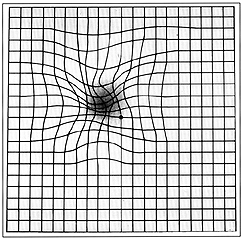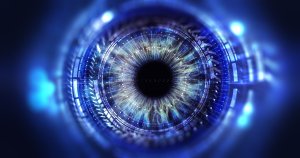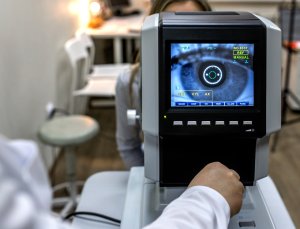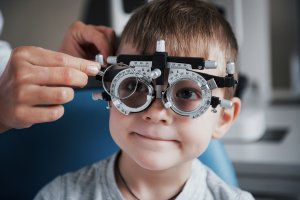Macular Degeneration

Voted Best of Berks—
eight years in a row!
What is Macular Degeneration?
Macular degeneration, or age-related macular degeneration (AMD) is a leading cause of vision loss in Americans 60 and older. It is a disease that destroys your sharp, central vision. You need central vision to see objects clearly and to do tasks such as reading and driving.
AMD affects the macula, the part of the eye that allows you to see fine detail. It does not hurt, but it causes cells in the macula to die. In some cases, AMD advances so slowly that people notice little change in their vision. In others, the disease progresses faster and may lead to a loss of vision in both eyes. Regular comprehensive eye exams can detect macular degeneration before the disease causes vision loss. Treatment can slow vision loss. It does not restore vision.
AMD Blurs Central Vision
AMD blurs the sharp central vision you need for straight-ahead activities such as reading, sewing, and driving. AMD causes no pain.
How AMD Progresses
In some cases, AMD advances so slowly that people notice little change in their vision. In others, the disease progresses faster and may lead to a loss of vision in both eyes. AMD is a common eye condition among people age 60 and older.
Two Forms of AMD
There are two forms of age-related macular degeneration — dry and wet.
Wet AMD: Wet AMD occurs when abnormal blood vessels behind the retina start to grow under the macula. These new blood vessels tend to be very fragile and often leak blood and fluid. The blood and fluid raise the macula from its normal place at the back of the eye.
Straight Lines Appear Wavy
An early symptom of wet AMD is that straight lines appear wavy. If you notice this condition or other changes to your vision, contact your eye care professional at once. You need a comprehensive dilated eye exam.
Wet AMD is More Severe
With wet AMD, loss of central vision can occur quickly. Wet AMD is considered to be advanced AMD and is more severe than most cases of the dry form.
Dry AMD: Dry AMD occurs when the light-sensitive cells in the macula slowly break down, gradually blurring central vision in the affected eye. As dry AMD gets worse, you may see a blurred spot in the center of your vision. Over time, as less of the macula functions, central vision in the affected eye can be lost gradually. The most common symptom of dry AMD is slightly blurred vision. You may have difficulty recognizing faces. You may need more light for reading and other tasks. Dry AMD generally affects both eyes, but vision can be lost in one eye while the other eye seems unaffected.
What Are Drusen?
One of the most common early signs of dry AMD is drusen. Drusen are yellow deposits under the retina. They often are found in people over age 60. Your eye care professional can detect drusen during a comprehensive dilated eye exam.
Three Stages of Dry AMD
Dry AMD has three stages — early AMD, intermediate AMD, and advanced dry AMD. All of these may occur in one or both eyes.
-
- People with early dry AMD have either several small drusen or a few medium-sized drusen. At this stage, there are no symptoms and no vision loss.
- People with intermediate dry AMD have either many medium-sized drusen or one or more large drusen. Some people see a blurred spot in the center of their vision. More light may be needed for reading and other tasks.
- In addition to drusen, people with advanced dry AMD have a breakdown of light-sensitive cells and supporting tissue in the macula. This breakdown can cause a blurred spot in the center of your vision.
In addition to drusen, people with advanced dry AMD have a breakdown of light-sensitive cells and supporting tissue in the macula. This breakdown can cause a blurred spot in the center of your vision.
Over time, the blurred spot may get bigger and darker, taking more of your central vision. You may have difficulty reading or recognizing faces until they are very close to you.
If Only One Eye is Affected
If you have vision loss from dry AMD in one eye only, you may not notice any changes in your overall vision.
With the other eye seeing clearly, you can still drive, read, and see fine details. You may notice changes in your vision only if AMD affects both eyes. If you experience blurry vision, see an eye care professional for a comprehensive dilated eye exam.
Risk Factors
The risk for AMD increases with age. AMD is most common in older people, but it can occur during middle age. Generally, though, the risk increases with age.
Other Risk Factors
Other risk factors include
-
- Smoking
- Obesity
- Race. Caucasians are much more likely to lose vision from AMD than African-Americans.
- Family history. People with a family history of AMD are at higher risk of getting the disease.
- Gender. Women appear to be at greater risk than men.
Symptoms and Diagnosis
AMD is detected during a comprehensive eye exam that includes a visual acuity test, a dilated eye exam, and tonometry. Tests for AMD include:
- The visual acuity test is an eye chart test that measures how well you see at various distances.
- In the dilated eye exam, drops are placed in your eyes to widen, or dilate, the pupils. Then, your eye care professional uses a special magnifying lens to examine your retina and optic nerve for signs of AMD and other eye problems. After the exam, your close-up vision may remain blurred for several hours.
Your eye care professional also may do other tests to learn more about the structure and health of your eye.
The Amsler Grid: During an eye exam, you may be asked to look at an Amsler grid, shown here. You will cover one eye and stare at a black dot in the center of the grid.

 Click here for a printable Amsler Grid
Click here for a printable Amsler Grid
While staring at the dot, you may notice that the straight lines in the pattern appear wavy. You may notice that some of the lines are missing. These may be signs of AMD.
Because dry AMD can turn into wet AMD at any time, you should get an Amsler grid from your eye care professional. You could then use the grid every day to evaluate your vision for signs of wet AMD.
The Fluorescein Angiogram Test: If your eye care professional believes you need treatment for wet AMD, he or she may suggest a fluorescein angiogram. In this test, a special dye is injected into your arm. Pictures are taken as the dye passes through the blood vessels in your eye. The test allows your eye care professional to identify any leaking blood vessels and recommend treatment.
Treatments
Once Dry AMD reaches the advanced stage, no form of treatment can prevent vision loss. However, treatment can delay and possibly prevent intermediate AMD from progressing to the advanced stage. The National Eye Institute’s Age-Related Eye Disease Study found that taking certain vitamins and minerals might reduce the risk of developing advanced AMD.
Wet AMD can be treated with laser surgery, photodynamic therapy, and injections into the eye. None of these treatments is a cure for wet AMD. The disease and loss of vision may progress despite treatment.
Laser Surgery: Laser surgery uses a laser to destroy the fragile, leaky blood vessels. Only a small percentage of people with wet AMD can be treated with laser surgery. Laser surgery is performed in a doctor’s office or eye clinic. The risk of new blood vessels developing after laser treatment is high. Repeated treatments may be necessary. In some cases, vision loss may progress despite repeated treatments.
Photodynamic Therapy: With photodynamic therapy, a drug called verteporfin is injected into your arm. It travels throughout the body, including the new blood vessels in your eye. The drug tends to stick to the surface of new blood vessels.
Next, the doctor shines a light into your eye for about 90 seconds. The light activates the drug. The activated drug destroys the new blood vessels and leads to a slower rate of vision decline.
Unlike laser surgery, verteporfin does not destroy surrounding healthy tissue. Because the drug is activated by light, you must avoid exposing your skin or eyes to direct sunlight or bright indoor light for five days after treatment. Photodynamic therapy is relatively painless. It takes about 20 minutes and can be performed in a doctor’s office.
Photodynamic therapy slows the rate of vision loss. It does not stop vision loss or restore vision in eyes already damaged by advanced AMD. Treatment results often are temporary. You may need to be treated again.
Drug Treatment for Wet AMD: Wet AMD can now be treated with new drugs that are injected into the eye (anti-VEGF therapy). Abnormally high levels of a specific growth factor occur in eyes with wet AMD and promote the growth of abnormal new blood vessels. This drug treatment blocks the effects of the growth factor.
You will need multiple injections that may be given as often as monthly. The eye is numbed before each injection. After the injection, you will remain in the doctor’s office for a while and your eye will be monitored. This drug treatment can help slow down vision loss from AMD and in some cases improve sight.
Find a Doctor
Physician information including education, training, practice location and more.
Schedule an Appointment
Call 800-762-7132 or make an appointment online.





